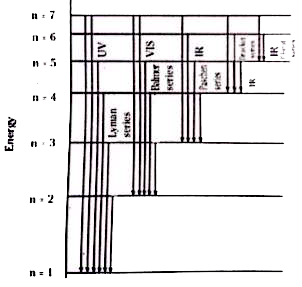What are the postulates of Bohr's model of hydrogen atom ? Discuss the importance of this model to explain various series of line spectra in hydrogen atom. Solution in Telugu
Postulates of Bohr's theory :
(1) Electrons revolve around the uncleus in certain , definite circular paths , called orbits . They are also known as energy levels or shells .
(2) Each orbit is associated with a definite amount of energy . Hence these orbits are called energy orbits or energy levels or energy shells .
(3) As the value of n increases , the size and energy of the orbit increases .
(4) As long as the electrons revolve in the circular orbits , they neither emit nor absorb energy . Hence , these orbits are also called stationary orbits .
(5) More than one stationary orbit is possible for any electron and the angular momentum of the revolving electron is quantized . That is , the electrons revolve in those circular orbits in which the angular momentum of the revolving electron is an integral multiple of h/2πr .
This can be expressed as mvr=n×h2π
where m = mass of the electron,
v = velocity of the electron
r = radius of the orbit ,
h = Planck's constant ,
n = Principal quantum number .
(6) The energy of electron changes when the electron jumps from one orbit to another orbit . When the electron jumps from a lower orbit to a higher orbit , energy is absorbed . Similarly when the electron jumps from a higher orbit to a lower orbit , erergy is emitted . The energy emitted or absorbed is given by the equation , Δ=E2−E1=hυ
where
E1 = Energy of lower orbits ,
E2 = Energy of higher orbits ,
ΔE = Difference in energy ,
h = Planck's constant,
υ = Frequency.
(B) Explanation of formation of different lines in various series of Hydrogen atomic spectrum : Hydrogen atom has only one electron and it revolves around the uncleus in the first orbit . When certain amount of hydrogen gas containing a large number of electrons , is heated or exposed to light energy or is subjected to electric discharge the different electrons absorb different amount of energy and get excited to different higher orbits. But , they do not stay there for longer peridos . Hence , they try to come back to lower orbits (de-excitation ) . This de - excitation need not necessarily be the same for all the atoms . Some excited electrons may come back from any of the hight energy levels to lower energy level n = 1 . Then Lyman series is formed in the U.V. region . Some excited electrons may come back from any of the higher energy levels to lower energy level n = 2 . Then Balmer series is formed in the visible region . Similarly , when the excited electron comes back , from any of the higher energy levels to lower 3 , 4 & 5 , we get Paschen , Bracket and Pfund series respectively in the I.R . region.
The de-excitation process from higher energy level to lower energy level also may take place in a single step or in different steps . For example , the de-excitation process of an electron from 4th energy level to 1st energy level can be as shown below.
Direct step : From 4th level to 1st (i.e.,) 4→1
Different steps : 4→3→2→1,4→3→1,4→2→1.
For each electronic transition one line is formed in the spectrum . Thus we get a large number of lines in a given series .

Topper's Solved these Questions
- BOOK - VGS PUBLICATION-BRILLIANTCHAPTER - ATOMIC STRUCTUREEXERCISE - ADDITIONAL QUESTIONS & ANSWERS22videos
ATOMIC STRUCTURE
- BOOK - VGS PUBLICATION-BRILLIANTCHAPTER - ATOMIC STRUCTUREEXERCISE - SHORT ANSWER QUESTIONS18videos
ATOMIC STRUCTURE
- BOOK - VGS PUBLICATION-BRILLIANTCHAPTER - AP MARCH-2018 I.P.E. PAPEREXERCISE - SECTION-C5videos
AP MARCH-2018 I.P.E. PAPER
- BOOK - VGS PUBLICATION-BRILLIANTCHAPTER - CHEMICAL BONDING AND MOLECULAR STRUCTUREEXERCISE - LONG ANSWER QUESTIONS9videos
CHEMICAL BONDING AND MOLECULAR STRUCTURE
Similar Questions
Calculate the number of protons , neutrons and electrons in .8035Br
01:48View SolutionWhat is the wavelength of light emitted when the electron in a hydrogen atom undergoes transition from an energy level with n = 5 to an energy level with n = 3 ?
06:19View SolutionWhat are the postulates of Bohr's model of hydrogen atom ? Discuss the importance of this model to explain various series of line spectra in hydrogen atom.
03:47View SolutionExplain the formation of Ionic Bond with a suitable example.
00:46View SolutionWhat are the various postulates of Bohr's model of atom? How could Bohr's model explain the existance of so many lines in the specturm of hydrogen?
01:59View SolutionState the postulates of Bohr's model of hydrogen atom .
05:18View SolutionState the postulates of Bohr's model of hydrogen atom .
01:24:23View SolutionWhich model successfully explained fine line structure of hydrogen atomic spectra?
57:55View SolutionWriter Bohr's postulates for the hydrogen atom model.
View SolutionWrite the postulates of Bohr's model of hydrogen atom. What are the limitations of Bohr's model of an atom ?
01:24:23View SolutionAtomic spectra of hydrogen | Bohr's model of atom | Bohr's postulates | Derivation of radius and velocity of Bohr's orbit
57:55View SolutionQuestion based on Photoelectric Effect | Atomic spectra of Hydrogen | Bohr's model of Atom| Bohr's postulates and derivation of radius and velocity of Bohr's velocity
01:59View SolutionExplain the postulates of Bohr's atomic model.
View SolutionAtomic spectra of hydrogen | Bohr's model of atom | Bohr's postulates | Derivation of radius and velocity of Bohr's orbit
02:35View SolutionPhotoelectric Effect Questions | Atomic spectra of Hydrogen Questions | Bohr's model of Atom| Bohr's postulates and derivation of radius and velocity of Bohr's velocity
03:33View Solution
